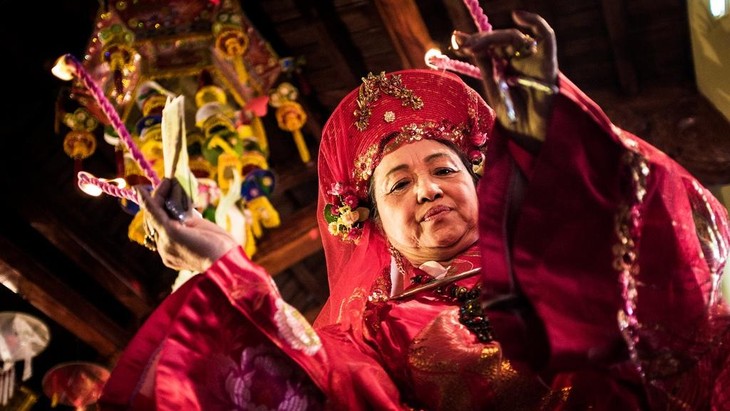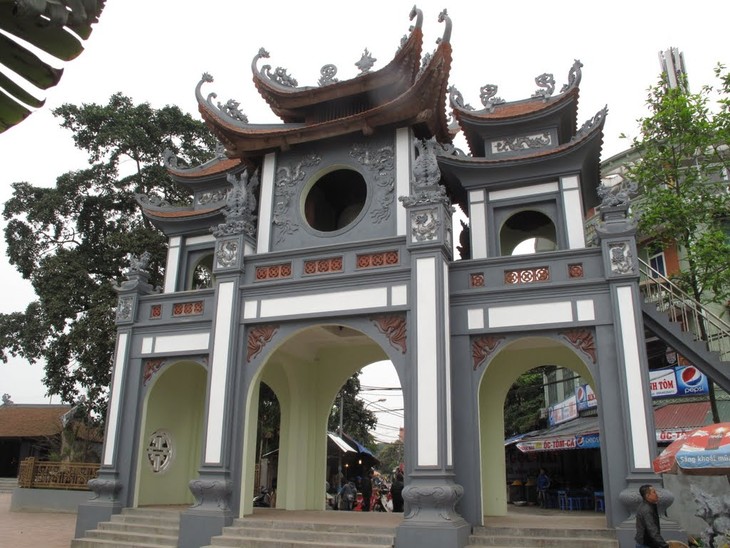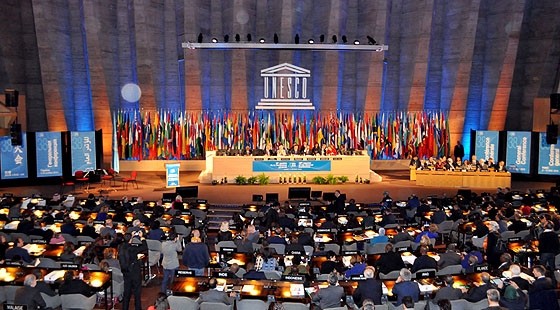(VOVworld) – Mother Goddess worship, or Đạo Mẫu”, is very popular belief in an agriculture-based country like Vietnam, where farmers strongly depend on nature. When people are happy and joyful, they come to the Mother; and when they feel sad, they seek comfort from Her. Even long before the UNESCO recognition as the world’s intangible cultural heritage last year, “Đạo Mẫu” has always been considered a unique part of Vietnamese culture.
Perhaps the most popular celebration of Đạo Mẫu, or Mother Goddess worship, known to Vietnamese people is “hầu đồng”, or trance ceremony. In the central stage, the medium dressed up in different colored silk robes to represent different deities, who are believed to bless people with health, luck, wealth, and protection. Around the medium, dozens of worshippers sit cross-legged with eyes wide open, watching the medium’s skillful movements.
 |
According to Dr. Nguyen Ngoc Mai's research, Đạo Mẫu belief and the trance ceremony has been practiced in Vietnam even before the Lý Dynasty in 1009. (Photo: english.vietnamnet.vn)
|
On the traditional orchestral music playing in the background, spirits of deities are invited to possess the medium, who will bring to life some of most distinctive characters and activities of the deities. For example, if the spirit was a general, the medium will perform some strong martial movements with a guan dao, and if the spirit was the Princess of Mountain and Forests, the medium will wear green robes with flashing jewelries. This performance is especially popular and highly anticipated by followers, as the “Princess” will throw real money to worshippers, symbolizing her bless of a good fortune to come to them in real life. Dr. Nguyen Ngoc Mai, head of Religious Study Department of Vietnam Academy of Social Sciences, said: “Hầu đồng, or trance ceremony, is a major spiritual activity practiced among Mother Goddess followers. According to my research, Đạo Mẫu belief and the trance ceremony has been practiced in Vietnam even before the Lý Dynasty in 1009. During this ritual, mediums will perform to praise deities, focusing on his/her biography, merits, appearance and characteristics”.
A hầu đồng ceremony, which involves a number of artistic elements such as music, singing, dance and the use of costumes, attracts not only Đạo Mẫu believers, but also foreigners. New York based photographer Tewfic El-Sawy has spent the last 2 years documenting the first-ever English book about “hầu đồng” of Vietnam. He said: “There are other ceremonies in other religions but they are not like hầu đồng at all. They are very different. I went to India and went to a ceremony but it was more severe and not happy. It was a little bit scary. Hầu đồng in Vietnam is otherwise; it is fun. I think it’s the happiness of the audience that is striking to me. I learnt that a lot of the Gods in hầu đồng are historical figures or national heroes. Hoàng Bảy, for instance, is real. He existed. He was in Lao Cai province and when the foreign invaders came to invade Vietnam, he pushed them back. So I think it’s the essence of Vietnam and the nationality of Vietnam”.
 |
| The biggest annual festival celebrated among Đạo Mẫu follower community is held in Phu Day temple, Nam Dinh province. During the festival, some unique activities are held to honor the Mother Goddesses such as word-arrangement. (Photo: Holiday2Travel) |
The biggest annual festival celebrated among Đạo Mẫu follower community is held in Phu Day temple, Nam Dinh province. Thousands of devotees make a pilgrimage to the temple to pay tribute to Princess Lieu Hanh, the leading Mother Goddesses in Vietnamese belief and one of the four immortals in Vietnamese folklore. The six-day event features numerous traditional rituals, including “hầu đồng” - an activity people usually mistook with the general belief. Professor Nguyen Chi Ben, former Director of Vietnam National Institute of Culture and Art Studies and head of the Vietnamese delegate to prepare, finalize and submit the Mother Goddess worship dossiers for UNESCO recognition, said: “Vietnam’s Mother Goddess worship includes various spiritual and cultural activities, not just the trance ceremony, for example a literature collection about Mother Goddess Lieu Hanh and other Vietnamese heroes. Or the most distinctive activity usually held in Phu Day Festival, the biggest festival to honor Mother Goddess in North Vietnam, is word-arrangement”.
 |
Medium and folk artisan Trinh Ngoc Minh said honoring Mother Goddess is part of the matrilineal descent system and represents the mother and her role in each family. (Photo: toixedich.com)
|
Princess Lieu Hanh is believed to be a daughter of Ngoc Hoang, or the Jade Emperor, who was sent to moral world to help Vietnamese people, especially poor farmers, and bless them with good crops and more income. She is the mother of all things and rules over four realms of Heaven, Earth, Water, and Mountain and Forests. However, to Trinh Ngoc Minh, a medium and a folk artisan from Hanoi, the main idea of Mother Goddess was to honor the figure of mothers and women in society. He said: “Mother Goddess religion is closely associated with Vietnamese people’s life. The image of Mother Goddess, which is part of the matrilineal descent system, actually represents the mother and her role in each family. That’s why people quickly feel connected with this religion. While growing up, children in Vietnam are taught the foremost and best way to worship goddess was to respect people around you, starting with your mother and father”.
According to Professor Nguyen Chi Ben, it is this humanity aspect of Đạo Mẫu that helps the belief be recognized as one of the world’s intangible heritage. He said: “By using the figures of heroine, Mother Goddess worship honors the universal love of mothers and women’s role in society. Maybe at the present, we are living in a more equal society but at the time Mother Goddess worship was form, when Taoism dominated, the idea to honor the women of Vietnamese people was very rare and humanity. This is one of the most significant value that UNESCO highly appreciated”.
 |
Tay Ho Temple (Phủ Tây Hồ) is one of the most well-known and sacred temples honoring Princess Lieu Hanh. (Photo: tinhtam.vn)
|
In Vietnam, especially in Northern provinces, most pagodas have an altar dedicated only Mother Goddesses. This altar is usually placed behind or by the side of the main altar for Buddha. But more commonly, Vietnamese people worship their Mothers in separated temple called “Phủ”. However, except for the main Mother Goddesses, each “phủ” will have a typical system of deities, put in different order. Professor Ben again: “We do not view the Mother Goddess worship is a religion but a growing belief because its a system of deities varies and is still developing. Except for the figure of Mother Goddess, who is Lieu Hanh, different temples can have different deities to worship. This is the main aspect that differ this belief to other religions in Vietnam whose deities were fixed and cannot be changed”.
Through a system of mighty Mothers and other national historical heroes, Mother Goddess worship promotes and encourages the good nature in each individual and the bond between people and people. It also represents the national resilience to win over foreign invaders and natural disasters, to build and protect Vietnam. Folk artisan and medium Trinh Ngoc Minh believes Mother Goddess worship is a great way to teach people about Vietnam’s history and traditions. He said: “Through trance performances and Mother Goddess Worshipping, people, especially the young generation, can learn more about the origins of our country, about ancestors. Hat van lyrics honors merits of many national heroes, who helped to expand and protect the country, or to bring wealth and prosperity to the people. They were considered as Great Mother and Father of Vietnamese people”.
 |
Recognized as UNESCO's intangible cultural heritage, Vietnam's Mother Goddesses of 3 Realms reflects the importance of spiritual needs in the daily life of the community. (Photo: Vietnam Economic Times)
|
Mother Goddess worship is purely of Vietnamese origins and among the oldest beliefs practiced in Vietnam. Followers are proud as the belief has stood the test of time and has been recognized by the UNESCO as a world’s intangible cultural heritage since December last year. However, concerns has been raised over some spiritual mediums who can exploit followers to spend large sum of money on holding expensive and unnecessary “hầu đồng” ceremonies, which they accept out of fear and desperation. Medium Vo Van Minh is worried. He hopes both the administration and followers will recognize and preserve the real value of Mother Goddess, instead of being taken advantage of. He said: “Before our Mother Goddess worship was recognized as an intangible cultural heritage of humanity, we, the mediums, and other followers still tried our best to maintain the traditions and values of our belief. We want to thank all the member of Vietnam’s delegation to UNESCO to help Mother Goddess worship to be honored. I just hope believers and the whole society will continue to preserve the true values of the worship”.